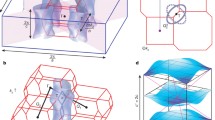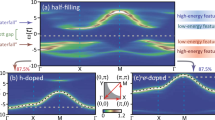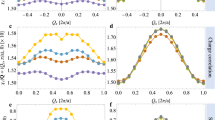Abstract
The material-specific electronic band structure of the electron-doped high- T c cuprate Nd1.85Ce0.15CuO4 (NCCO) is calculated in the pseudogap regime using the recently developed generalized LDA + DMFT + Σ k scheme. The LDA/DFT (density-functional theory within local density approximation) provides model parameters (hopping integral values and local Coulomb interaction strength) for the one-band Hubbard model, which is solved by the DMFT (dynamical mean-field theory). To take pseudogap fluctuations into account, the LDA + DMFT is supplied with an “external” k-dependent self-energy Σ k that describes interaction of correlated conducting electrons with nonlocal Heisenberg-like antiferromagnetic (AFM) spin fluctuations responsible for the pseudogap formation. Within this LDA + DMFT + Σ k approach, we demonstrate the formation of pronounced hot spots on the Fermi surface (FS) map in NCCO, opposite to our recent calculations for Bi2Sr2CaCu2O8 − δ (Bi2212), which have produced a rather extended region of the FS “destruction.” There are several physical reasons for this fact: (i) the hot spots in NCCO are located closer to the Brillouin zone center; (ii) the correlation length ξ of AFM fluctuations is longer for NCCO; (iii) the pseudogap potential Δ is stronger than in Bi2212. Comparison of our theoretical data with recent bulk-sensitive high-energy angle-resolved photoemission (ARPES) data for NCCO provides good semiquantitative agreement. Based on that comparison, an alternative explanation of the van Hove singularity at −0.3 eV is proposed. Optical conductivity for both Bi2212 and NCCO is also calculated within the LDA + DMFT + Δ k scheme and is compared with experimental results, demonstrating satisfactory agreement.
Similar content being viewed by others
References
T. Timusk and B. Statt, Rep. Prog. Phys. 62, 61 (1999); M. V. Sadovskii, Usp. Fiz. Nauk 171, 539 (2001) [Phys.—Usp. 44, 515 (2001)].
A. Damascelli, Z. Hussain, and Z.-X. Shen, Rev. Mod. Phys. 75, 473 (2003); J. C. Campuzano, M. R. Norman, and M. Randeria, in Physics of Superconductors, Ed. by K. H. Bennemann and J. B. Ketterson (Springer, Berlin, 2004), Vol. II, p. 167; J. Fink, S. Borisenko, A. Kordyuk, et al., arXiv:cond-mat/0512307; X. J. Zhou, T. Cuk, T. Devereaux, et al., arXiv:cond-mat/0604284.
A. Georges, G. Kotliar, W. Krauth, and M. J. Rozenberg, Rev. Mod. Phys. 68, 13 (1996).
E. Z. Kuchinskii, I. A. Nekrasov, and M. V. Sadovskii, Pis’ma Zh. Éksp. Teor. Fiz. 82(4), 217 (2005) [JETP Lett. 82 (4), 198 (2005)].
M. V. Sadovskii, I. A. Nekrasov, E. Z. Kuchinskii, et al., Phys. Rev. B: Condens. Matter 72, 155105 (2005).
E. Z. Kuchinskii, I. A. Nekrasov, and M. V. Sadovskii, Low Temp. Phys. 32, 528 (2006).
J. Schmalian, D. Pines, and B. Stojkovic, Phys. Rev. B: Condens. Matter 60, 667 (1999).
É. Z. Kuchinskiĭ and M. V. Sadovskiĭ, Zh. Eksp. Teor. Fiz. 115(2), 1765 (1999) [JETP 88 (2), 347 (1999)].
R. O. Jones and O. Gunnarsson, Rev. Mod. Phys. 61, 689 (1989).
K. Held, I. A. Nekrasov, G. Keller, et al., Psi-k Newsletter 56, 65 (2003) [psi-k.dl.ac.uk/newsletters/News_56/Highlight_56.pdf]; K. Held, Adv. Phys. 56, 829 (2007).
K. G. Wilson, Rev. Mod. Phys. 47, 773 (1975); H. R. Krishna-murthy, J. W. Wilkins, and K. G. Wilson, Phys. Rev. B: Condens. Matter 21, 1003 (1980); Phys. Rev. B: Condens. Matter 21, 1044 (1980); A. C. Hewson, The Kondo Problem to Heavy Fermions (Cambridge University Press, Cambridge, 1993).
R. Bulla, A. C. Hewson, and Th. Pruschke, J. Phys.: Condens. Matter 10, 8365 (1998).
E. Z. Kuchinskii, I. A. Nekrasov, and M. V. Sadovskii, Phys. Rev. B: Condens. Matter 75, 115102 (2007).
E. Z. Kuchinskii, I. A. Nekrasov, and M. V. Sadovskii, Zh. Éksp. Teor. Fiz. 133(3), 670 (2008) [JETP 106 (3), 581 (2008)].
E. Z. Kuchinskii, I. A. Nekrasov, Z. V. Pchelkina, and M. V. Sadovskii, Zh. Éksp. Teor. Fiz. 131(5), 908 (2007) [JETP 104 (5), 792 (2007)]; I. A. Nekrasov, E. Z. Kuchinskii, Z. V. Pchelkina, and M. V. Sadovskii, Physica C (Amsterdam) 460–462, 997 (2007).
M. V. Sadovskiĭ, Zh. Eksp. Teor. Fiz. 77(5), 2070 (1979) [Sov. Phys. JETP 50 (5), 989 (1979)].
M. V. Sadovskiĭ and N. A. Strigina, Zh. Éksp. Teor. Fiz. 122(3), 610 (2002) [JETP 95, 526 (2002)].
J. M. Tarascon, Y. Le Page, P. Barboux, et al., Phys. Rev. B: Condens. Matter 37, 9382 (1988); S. A. Sunshine, T. Siegrist, L. F. Schneemeyer, et al., Phys. Rev. B: Condens. Matter 38, 893 (1988).
T. Kamiuama, Physica C (Amsterdam) 229, 377 (1994).
O. K. Anderson, Phys. Rev. B: Solid State 12, 3060 (1975); O. K. Andersen and O. Jepsen, Phys. Rev. Lett. 53, 2571 (1984).
M. Hybertsen and L. Mattheiss, Phys. Rev. Lett. 60, 1661 (1988).
S. Massidda, N. Hamada, Jaejun Yu, and A. J. Freeman, Physica C (Amsterdam) 157, 571 (1989); S. Matsuno and H. Kanimura, J. Supercond. 7, 517 (1994).
N. Marzari and D. Vanderbilt, Phys. Rev. B: Condens. Matter 56, 12847 (1997); Wei Ku, H. Rosner, W. E. Pickett, and R. T. Scalettar, Phys. Rev. Lett. 89, 167204 (2002).
V. I. Anisimov, D. E. Kondakov, A. V. Kozhevnikov, et al., Phys. Rev. B: Condens. Matter 71, 125119 (2005).
O. K. Andersen and T. Saha-Dasgupta, Phys. Rev. B: Condens. Matter 62, R16219 (2000); O. K. Andersen, T. Saha-Dasgupta, S. Ezhov, et al., Psi-k Newsletter 45, 86 (2001); O. K. Andersen, T. Saha-Dasgupta, and S. Ezhov, Bull. Mater. Sci. 26, 19 (2003).
M. Korshunov, A. Gavrichkov, S. G. Ovchinnikov, et al., Zh. Éksp. Teor. Fiz. 126(3), 642 (2004) [JETP 99 (3), 559 (2004)]; M. M. Korshunov, V. A. Gavrichkov, S. G. Ovchinnikov, et al., J. Phys.: Condens. Matter 19, 486203 (2007).
O. K. Andersen, A. I. Liechtenstein, O. Jepsen, and F. Paulsen, J. Phys. Chem. Solids 56, 1573 (1995).
O. Gunnarsson, O. K. Andersen, O. Jepsen, and J. Zaanen, Phys. Rev. B: Condens. Matter 39, 1708 (1989).
N. M. Plakida and V. S. Oudovenko, Zh. Éksp. Teor. Fiz. 131(2), 259 (2007) [JETP 104 (2), 230 (2007)].
I. A. Nekrasov, K. Held, N. Blümer, et al., Eur. Phys. J. B 18, 55 (2000).
I. A. Zobkalo, A. G. Gukasov, S. Yu. Kokovin, et al., Solid State Commun. 80, 921 (1991); E. M. Motoyama, G. Yu, I. M. Vishik, et al., Nature (London) 445, 186 (2007).
M. V. Sadovskii, E. Z. Kuchinskii, and I. A. Nekrasov, Physica C (Amsterdam) 460–462, 1084 (2007).
N. P. Armitage, F. Ronning, D. H. Lu, et al., Phys. Rev. Lett. 88, 257001 (2002).
A. Kaminski, H. M. Fretwell, M. R. Norman, et al., Phys. Rev. B: Condens. Matter 88, 257001 (2002).
I. A. Nekrasov, E. E. Kokorina, E. Z. Kuchinskii, et al., arXiv:0708.2313.
S. V. Borisenko, M. S. Golden, S. Legner, et al., Phys. Rev. Lett. 84, 4453 (2000).
M. Tsunekawa, A. Sekiyama, S. Kasai, et al., J. Electron Spectrosc. Relat. Phenom. 144–147, 541 (2005); M. Tsunekawa, A. Sekiyama, S. Kasai, et al., New J. Phys. 10, 073005 (2008).
Y. Onose, Y. Taguchi, K. Ishizaka, and Y. Tokura, Phys. Rev. Lett. 87, 217001 (2001).
M. A. Quijada, D. B. Tanner, R. J. Kelley, et al., Phys. Rev. B: Condens. Matter 60, 14917 (1999).
Y. M. Vilk and A.-M. S. Tremblay, J. Phys. I 7, 1309 (1997).
Author information
Authors and Affiliations
Corresponding author
Additional information
The text was submitted by the authors in English.
Rights and permissions
About this article
Cite this article
Kokorina, E.E., Kuchinskii, E.Z., Nekrasov, I.A. et al. Origin of “Hot Spots” in the pseudogap regime of Nd1.85Ce0.15CuO4: An LDA + DMFT + Σk study. J. Exp. Theor. Phys. 107, 828–838 (2008). https://doi.org/10.1134/S1063776108110137
Received:
Published:
Issue Date:
DOI: https://doi.org/10.1134/S1063776108110137




